What Is Video API: The Ultimate Guide For Developers [2025]
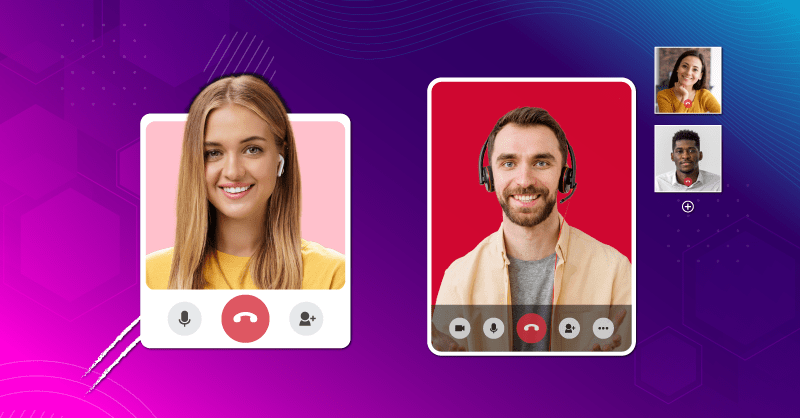
Still writing long codes to build video calls in your app? I’m here with good news! You can add a video calling feature to your business app in just a few mins – with a video API.
Codes not behaving as expected when the deadline is approaching is the worst nightmare a developer can ever face. But that’s not happening anymore, especially if you are set to build apps with video calls.
I can be sure of what I’ve stated above, because video APIs are here for the save.
Now, for those who are not familiar with what a video API is, this article is exclusively for you.
Attention please!
The term ‘Video API’ may give you the impression that it is something about video content or media streaming.
But the video API we will discuss here will be all about video calling functionality – the one you’ll use to chat face to face online with your friends, team members, or clients.
Table of Contents
Understanding Video APIs (From The Scratch) 🔍
| What Is A Video API? A Video API is a software that you can add to your existing web or mobile apps to enable real-time video calling capabilities, without requiring extensive coding or changes. |
Developers often use this simple, pre-written piece of code to add video calling features to their apps. Instead of spending a long time writing every line of code themselves, they can simply purchase a video API from a reliable provider and add it to their app’s source code.
This way, within just a matter of a few minutes, their apps will have the ability to make and receive video calls in real-time.
How Do Video APIs Work In Communication Apps?
We’ve been there. Meeting our clients and teammates virtually is a regular activity for most of us, almost every day. But how do these remote video conferences happen?
That’s an interesting story!
Can you imagine what happens when you make a video call to your team? Which technology connects you both? How can no other participant enter the call between you and the other person?
Let’s find them all out!
1. Initialization & Authentication
When you integrate a video call API into an app, the API will include all the necessary libraries and SDKs to run video calls on the app.
Now, the app cannot immediately accept an API into its source code. It needs to authenticate the API. This is where, the API keys/ tokens come into action. The app reads the API key, verifies the API and allows the API to implement video calling.
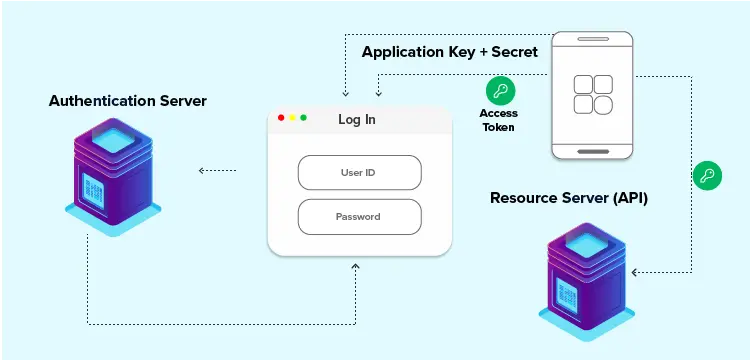
with Tokens
2. Call Creation
Now that the API is initialized, we need participants.
Right after the API is integrated, the app is now capable of making video calls. The app will generate a session ID, and the API will generate a token ID to authorize each participant joining the call.
3. Setting Up Server Connection
How will the devices of the participants connect? This is where the API will work. It will gather the meta data, like IP addresses and ports, from each user device, and exchange it with each other.
This way, each device connected to the ongoing call will know the connection details of other devices to stay connected.
Now, how does the API know the IP address of the devices connecting to the call? Wouldn’t firewalls block access? To bypass this situation, the video call API uses a STUN server to read the public IP address and make the connection.
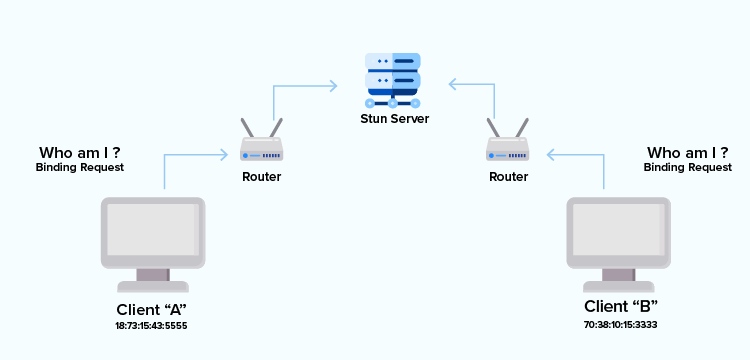
Now this is a video call, and the API uses the TURN server to relay the media if the direct connection between the peers fails.
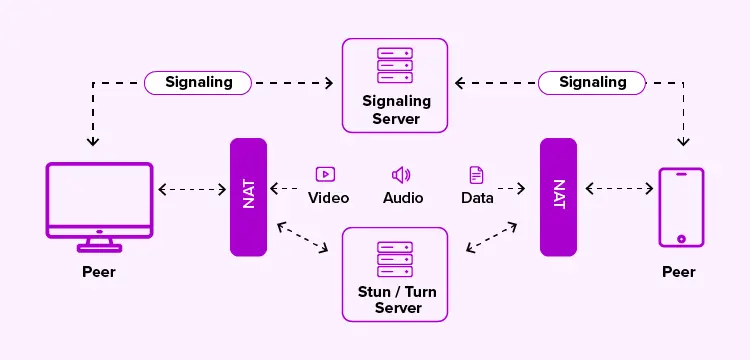
4. Video API Handling Media
The API captures video and audio from the user’s camera and microphone. This media cannot be directly sent to the other person’s device connected to the call.
The challenge here will be transmitting the media data, without falling prey to security risks during the transmission. On account of this situation, the API captures the data, encodes it into codecs like H.264 (video) and Opus (audio), and transmits it via a secure protocol like WebRTC.
The highlight of using WebRTC here is that the media will be exchanged at low latency and the communication will happen in real-time.
The media streams that are received by the receiving devices are decoded back into relevant audio and video formats. The API again takes on the responsibility of playing the video on the user’s screen and the audio through the device’s speakers or headphones.
5. Error Handling
Everything might not be as smooth as we read this. There may be hitches, like network issues, that would affect how the call connects. In this scenario, the API takes care of identifying the reason that is causing the error in the connection. Meanwhile, it also takes care of the situation by reconnecting the call and adjusting the media quality.
Well, that’s exactly what happens behind the scenes of every video call, that uses a video call API.
But is that all? Does the API for video only do the connecting work? No! A video API can bring loads of features to the app. Here is a list of features that you’ll be able to add to your app.
Note: The features mentioned are commonly available with most video API providers. This may differ depending on each provider.
Key Features Of A Video API
Here are a few features that video API comes with to connect and engage users via remote video meeting.
- 1:1/ Group Calls – Connect one or more individuals via one-to-one or many-to-many private chat.
- Video Conferencing – Drive conversations among multiple users over online video calls.
- Instant messaging – Real-time chat for conversations in text format.
- Video Frame Capture – All the images captured via front and back cameras are displayed at a specific frame rate frequency for better video experiences. This frame rate frequency is expressed in FPS (frames per second)
- Secure File Sharing – Enable sharing of files and other media securely during a video chat.
- Call Recording – Allow users in any channel or group to record conversations for future use.
- Switch to Video Calls – Participants can switch back and forth from audio-enabled calls to high resolution video calls during an ongoing session.
- Call Reconnecting – Call gets reconnected automatically when disconnected due to network issues.
- Call History – Users can keep track of all the video calls made to-date using the search feature.
- Call Muting – Allows users to mute their own audio during a live video session.
- Call Backup – Maintain a backup of past conversations. Enable retrieving the details on any new device that the user logs in to make calls.
- Incoming Call Notifications – Users will be notified when a video call is received or missed.
- Metrics and Analytics – Learn how the app performs by measuring the number of active online users, offline participants, clicks, downloads, files transferred, session length, and more.
- Join via call link – Allow users to join a scheduled or ongoing meeting via a pre-generated link.
- Schedule calls – Enable users to schedule a meeting at a specific time.
- Synchronize calls – Synchronize the scheduled calls in the users’ calendar.
Benefits Of Using Video APIs
There are a million reasons why you need to use a video platform API for building online meeting apps. I’ve listed the top benefits among them.
- Saves Development Time:
With a video API, you need not sit long hours in front of your computer and struggle with writing fresh codes. I understand that writing codes can be interesting, but you can use this enthusiasm elsewhere because you already have this video functionality ready-made in the form of a video API.
- Build Custom Apps
Since a video API usually comes with a bunch of features, it makes it easy for you to build a fully custom app. In simple words, you can build any kind of app with video call functionality in it.
- Highly Scalable
Don’t worry about scaling your app up or down. A video API regularly scales to your needs, and customizing it is easier than you think.
- Deliver A Personalized Experience
Adding video calling to your app is a truly great strategy to drive engagement in your app. Users can connect with your brand or with other users securely on your own app, without having to leave a third party app to meet virtually.
This way, you can give a personal touch to your app, making users engage easily with your own features.
- Cost-efficient
Now comes the most important reason. You save a lot of money when you use a video API to build your app. Imagine spending out all your hard-earned money on resources and tools to build video calling, while you can spend only a fraction of it and get fully built video chat functionality. Choose wisely!
Challenges Of Using Video APIs
Nothing comes all bright and right. Likewise, using a video platform API poses its own challenges and risks when using it in a business app.
- Latency and Quality
If you do not choose the right video API, the first thing your users will face is a delay in communication. Have you not experienced it yourself? Videos freezing in an important conversation, audio delaying, or overlapping.
How would your users react when they needed to stay in a long, crucial conversation with such quality issues? This is where you’ll need a video API that handles real-time communication at the lowest possible latency.
Read more about low-latency here.
- Security Concerns
One of the biggest threats while using video calling, especially in conversations involving confidential or sensitive information, is the security of the app. The video call API that you use must not risk user conversations at any point of time.
If the video API you choose does not support end-to-end encryption, or abide by privacy regulations, it means you are risking your users’s data and conversations.
- Integration Complexity
Not all video APIs make integration a walk in the park. There are a few API that can give you the feeling that hand-coding the video feature is easier than than the integration. So beware, go through the tutorials and documentation to first understand how well you can handle the API and then choose it.
- Limited Features
A video API must be a package of features. Imagine purchasing a video API that has only a short list of features. That’s going to double your development time and process. You’ll need a video API that comes with at least 500+ features while fitting it all within your budget.
(Here’s a secret tip – MirrorFly’s video API comes with 1000+ features. Everything is customizable and super-easy to integrate!)
Recommended Reading
Factors To Consider When Choosing A Video API
You may now have the question – ‘How do I choose a video API?’. There are thousands of video APIs out there. But which one is the best for you?
Alright, I’ve listed a few factors below. You can use them to prepare a checklist before you make the purchase.
- SIP/ VoIP Calling
You must choose a video API that is capable of integrating with SIP/ VoIP protocols. Which means, even if there is a long terms internet outage, your users can make use of your application to make calls using the extension or session address.
- Cross Platform
We know that each web browser and mobile platform is different, and so, it is required that the API you choose be compatible to operate on the web, Android, and iOS platforms.
- WebRTC Technology
Usually, video APIs are built on top of the standard WebRTC technology that allows streaming of real-time video across different browsers without the need for plugins.
- Security
It is a major factor to consider when choosing a video API. At the onset, they must provide security standards like E2E encryption, AES encryption, and SSO credibility. And, there could be cases where APIs can be hacked. To avoid such a case, APIs should come into full compliance with GDPR and HIPAA to prevent any type of data breach.
- Managing Bandwidth
From the outset, it is clear that businesses that offer live streaming look out for a way to manage their call bandwidth. And integrating a flexible video call SDK to a video chat can handle the bandwidth of a call and provide quality calls too.
- UI and Design Layouts
Traditional or older APIs require developers to create a video-calling user interface. At best, some offer kits that have not necessarily gone through testing and feedback cycles. Whereas, a full-featured video API gives you a drag-drop widget option, taking care of the entire app’s UI. Along with this, they also let you make customizations. Check out such an API that comes with UI kit here.
Multi-tenancy Mode
Multi-tenancy mode helps prevent security-breach of data. When this mode is configured, users assigned to a team can connect and converse with users of the same team in their respective channels. They will not be able to connect with teams that they are not aligned with.
Read more about multi-tenancy here.
- Hosting Flexibility
One more crucial factor you must consider is the freedom of deployment that the video API offers. Some of the video APIs are built to support the video communication infrastructure only on cloud servers.
This may affect how the video API performs on your app. Considering this, you need to choose a provider that supports deploying your app on-premise and on-cloud servers flexibly.
Key Takeaways
We’ve seen it all about video APIs. From how it works to how to choose it for your next project, we’ve covered it all.
To sum up, using a video API is the best option for building video calling apps, that too, within a short period of time. Plus, video APIs can save a lot of time, so you can focus on the core strategies of your business. They are easy to integrate and come with loads of pre-built features.
Well, if you’ve already made up your mind to go with a video API, you’ll find this comparison list of the top video API providers very useful.
Go ahead, build you next big app today!
Frequently Asked Questions (FAQ)
Is there any limit to how many participants can use the MirrorFly video?
There is no limit to the number of participants in MirrorFly self-hosted video SDKs. But there might be certain restrictions when you go with a monthly subscription plan. Talk with the salesperson to choose your best plan with a high number of participants.
When would a video API be necessary?
A video API is necessary in terms of building a faster and more responsive video call or chat app. The video API functionalities can be integrated in minutes with feature-rich APIs and SDKs. For any business looking to add video calling functionalities for promoting team collaboration, increased customer support, or conferencing, the video API is the best source.
What are the benefits of using video API?
The three major benefits of video APIs are
1. Increased productivity
2. Faster time to market
3. Cost and time-effectiveness in development
Further Reading
- 10 Best Live Video Calling APIs In 2025
- 10+ Best Voice Call APIs & SDKs Providers In 2025
- How to Integrate Video Call API into Your Android & iOS Apps?
- How to Build a Live Video Chat App in 2025?
- Create a JavaScript Video Chat App in 2025 – A Complete Guide!

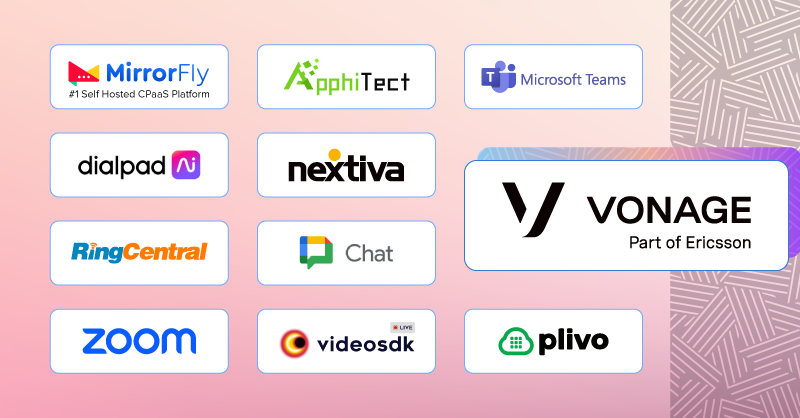
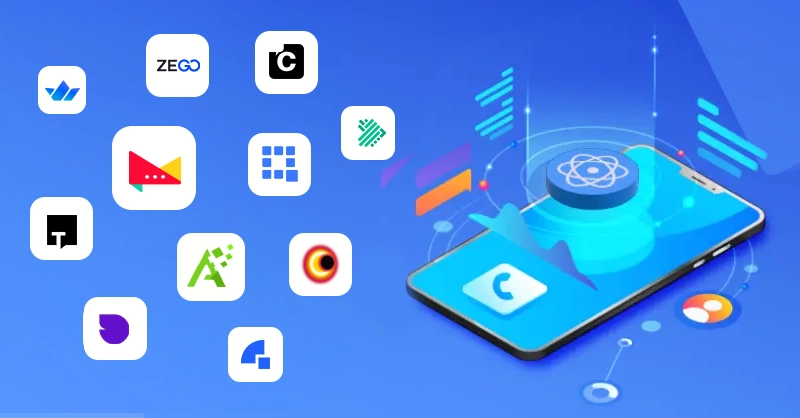
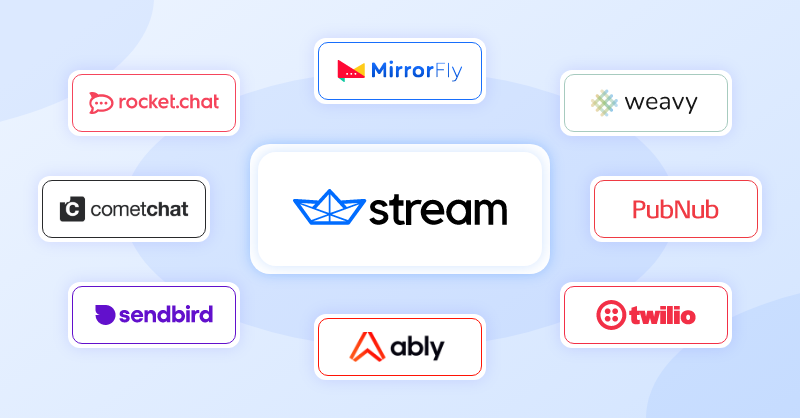
I have to build an video app for both android and iOS. I want to have a look at your video API demo?
Hi Team, I have a team and i want to have a testing for video api to build my own android app for healthcare communication.
Hi team, I want to make an app for travel ticket booking, My requirement is i need to develop an video app with webrtc. Let me know how to use your video API
Hi Team, Looks for subscription based Video Call API
Hi my product is based on CRM work flow management and I want a app for my android and ios video api with 1-to-1 and group voice/video call..
We are a production company based out of chennaI and we are looking for an webrtc video call app. We would like to know more about your video API pricing and other commercial details from your team.
We are looking for a video app using webrtc for our website. We are a tutoring agency and the service would be for communication between studends and faculities. Could you please share your video API details. Thanks
We are looking for a digital solution to unify WhatsApp & Instagram chats as well as out e-commerce platforms when launched, we need to know two main aspects that are affecting our choice of digital solutions: 1) Does your video api support Arabic language? 2) Does it support communications about medicine? as we are a pharmacy dealing with both medical and beauty items.
Hi Myself Sachin. I am a Software Enginner, also a youtuber. I am looking for a free developer account to use a chat & video api, which i will use in my videos at my youtube channel to demonstrate how to make apps like insta or whatsapp . Can you provide me a developer account with your SDK features, I can mention about Your SDK as well in my video . Let me know if can be used. Thanks .
We are looking for an alternative of video api and sdk for my e-learning mobile app (Android & iOS)